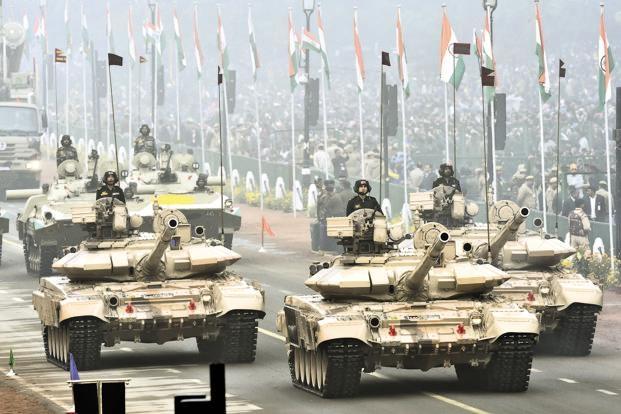New Defence Production Policy: Alice in Wonderland!

The Government recently announced a long-delayed Defence Production Policy (DPP 2018), coming after many years of continually updated defence procurement policies whose emphasis was on purchase of military hardware, invariably from foreign sources. These columns have long advocated the need for a defence production policy, with an emphasis on indigenous technology development and manufacturing, without which India would continue on the path of serial imports with consequent external dependence, security risk, and erosion of sovereignty. From that point of view, the release of DPP2018 is welcome, as at least a first step towards a policy framework for this critical national task. However, the policy as framed misconceives the goals, suggests measures which simply cannot achieve them, and engages in much wishful thinking. DPP 2018 in its present form requires to be totally recast.
Fantasy goals, flawed strategy
DPP 2018 starts by ostensibly acknowledging the overarching goal of self-reliance in defence production, and lamenting the fact that India had become the world’s largest importer of military hardware despite the efforts of defence public sector units (DPSUs) and DRDO. To remedy this, it calls for measures leading up to a “vibrant defence industry.” Subsequent sections make it evident that the intent is to enable much of this industry to be in the private sector, especially by acquiring know-how and investments from foreign manufacturers, even while leveraging and linking up with the experience and capability of DPSUs and the mostly State-owned R&D infrastructure.
DPP 2018 then sets objectives that can only be characterized as fantasies. From a starting point today where India imports almost all its advanced military hardware, except in a very few segments such as some missile types or basic light arms and ammunition, the Policy aims to “make India among the top five countries of the world in Aerospace and Defence industries,” and to “achieve self-reliance in development and manufacture… latest by 2025,” that too in a wide array of military hardware such as fighter aircraft, helicopters, warships, land combat vehicles, artillery and gun systems, small arms, electronic warfare, communication and surveillance systems. In other words, everything under the sun! As discussed later, a more specific list of weapons platforms, strategically selected to build key national weapons development and manufacturing capabilities, while delivering critical defence requirements, should have been conceived and spelt out.
This long wish list extends to increasing value of defence production to Rupees One lakh seventy thousand crores by 2025, a three-fold increase, stepping up exports to Rs.35,000 crores, up from the current around Rs.15,000 crores, and creating 2 to 3 million jobs, roughly 5-10 times current employment in the sector. There seems to be little correlation between these figures and the wish list for indigenous production, and one wonders if these projections have any realistic basis at all!
The strategies the Policy seeks to pursue so as to attain these goals are perhaps more revealing of the government’s thinking as regards practical measures. DPP2018 seeks to achieve its goals by, among other things, “fostering a competitive [and] innovative defence industry,” “encouraging collaborations to acquire latest technologies, manufacturing processes... and R&D,” “enabling ease of doing business,” and “enhancing defence exports.”
These reveal a faulty diagnosis of reasons behind India’s dependence on imports, as well as a deeply flawed prescription for the way forward. This also reflects a fundamentally mistaken understanding about the nature of the defence industry and its relationship with the government, not just in India but the world over.
Myth of Competition
In government thinking going back almost two decades but crystallizing in several recent pronouncements and in DPP 2018 in particular, there is an assumption that defence PSUs and the Ordinance Factories have not delivered because of a lack of competition which has hampered efficiency and innovation. The private sector, it is further assumes, inherently possesses these qualities and should therefore be given a greater role in defence manufacturing and even research, which would also help in broadening the defence industrial base. It follows that Indian private sector involvement be encouraged through measures to increase “ease of doing business” and other incentives.
A brief examination of the structure and procedures of defence R&D and manufacturing in countries with strong defence industries who India wishes to emulate would show the shallowness of such an understanding.
Many of these countries have a very strong state sector presence or role. The erstwhile Soviet Union and now Russia are obvious examples. Here almost all military platforms have been developed under conditions of state monopoly. In aviation, while the Sukhoi and MiG bureaus co-existed for long, there is no history of competition between them and, in rare situations of rival designs, the State quickly plumped for one or the other. Sukhoi, MiG and other Russian military aviation majors have now been brought under a single primarily state-owned umbrella corporation. Yet, MiGs and Sukhoi fighters remain among the best in the world, and India has been among their leading customers and partners in licensed production.
British Aerospace was created some decades ago by merging several independent aviation and electronics companies, many with a substantial government stake, chiefly to enable competition with American majors. Even when these were fully private, they were closely tied to the government, especially during WWII. Whereas the British government divested itself of its shares in BAe under Thatcherite policies, except for veto power against foreign ownership or control, the government retains a dominant say in its operations and the corporation is totally dependent on government contracts for its military platforms. The Tornado and Sea Harrier fighters, as well as the Eurofighter recently made in collaboration with other European companies, have been very successful in European and NATO air forces. These platforms were all developed and made through government funding with close military-civilian monitoring and specifications based on armed forces requirements, all without any competition whatsoever. Same is the case with Dassault of France, in which the government has substantial stake, and which is virtually a monopoly supplier to the French Air Force, just as Saab is in Sweden.
Even US military aviation majors Boeing and Lockheed Martin are heavily dependent on government support. Most new platforms are developed through government grants. The F-35 did evolve through a competition between the two big US aviation majors, but with the government funding design and prototype development by both, finally choosing Lockheed Martin’s. Broad specifications were, however, laid down by the civilian-military leadership at the Pentagon, the multi-role platform being expected to act as the mainstay of all three arms of the services till 2070, replacing existing specialized platforms namely the F-15, F-16 and F/A-18. Despite the competitive design process, the programme and the aircraft have been heavily criticized for cost and time overruns, and for various performance deficiencies.
Lead role of Governments
Private ownership or competition are not the prime drivers of quality or manufacturing efficiency of weapons systems. Fact is, weapons development does not take place in an imaginary process wherein different platforms are developed on their own by companies in competition with each other, with the government then choosing the preferred option. Instead, armed forces and strategic planners, along with the government, decide on weapons systems together and with a long-term view, fund their development and then place orders for manufacture. This is regardless of whether the armaments companies are public or private.
The whole system visualized by DPP 2018, wherein mostly private companies and a few DPSUs thrown in for good measure would competitively develop weapons platforms thus leading to cost and time efficiency as well as giving user agencies the ability to choose from different products is a complete myth! This may work with cars or refrigerators, but not in military equipment. To argue, as DPP2018 does, that “open competition, besides maximizing returns on money, is the greatest driver for innovation and productivity, and therefore will remain at the core of defence procurement,” is wholly misconceived and completely misunderstands the way in which weapons systems are conceived and developed.
DPP 2018 unfortunately does not recognize that the government, including the military, has to take the lead role in drawing up specifications for the desired weapons systems, themselves conceived with a long-term and strategic vision that stretches well beyond the temporary tenures of elected governments.
The weaknesses of the DPSUs and Ordinance Factories have been due to the utter failure of the government, both the political leadership and the civilian bureaucracy, to play such a lead role, ensuring that the military is a full partner in the development of major defence platforms and closely monitoring their manufacture. In India, there has been a deplorable tendency to take short-term views, chop and change specifications for weapons systems, provide poor and inconsistent funding for R&D, and lack of strategic planning. That is what DPP 2018 should have addressed but tragically does not, instead offering false solutions.
Tucked away in a section on innovation is the idea to set up “a High Level mechanism with involvement of Service organizations and HQIDS will be set up for identifying capability voids and defining critical technologies required for indigenous research/manufacturing in consultation with industry and academia. They will provide advice regarding technology platforms, which should be developed in the country in the medium and long term.”
This is actually what DPP 2018 should have focused on but tragically does not, instead putting forward impossible wish lists and other false solutions. A compact list of Missions targeting specific weapons platforms of lasting utility, delivering new technologies across different domains, and with potential to catalyze an advanced manufacturing ecosystem, should have been identified. The desired goals of promoting SMEs and other private sector industries for manufacturing of components and sub-assemblies would be achieved while also indigenously delivering required weapons platforms. Offsets, instead of being seen as stand-alone projects aimed at retaining part of acquisition expenses and generating domestic jobs, as has been the practice and also as visualized in DPP 2018, could then be strategically planned and integrated with these Missions so as to add to self-reliant developmental and manufacturing capability.
Without such a vision behind a Defence Production Policy, many wasted years and dangerous pitfalls lie ahead.
FDI and private sector delusion
The biggest of these is the strategy being assiduously pushed, including in DPP 2018, to attract FDI from and collaboration with foreign armaments majors as a means to set up manufacturing bases in India and acquire advanced technologies. In pursuit of this dream, and in the face of marked reluctance by global arms majors to oblige, the present government has raised the FDI ceiling from 26% to 49% and even higher in exceptional cases of advanced technology transfer. No clearer message conveying the abject failure of this strategy is required than the fact that only a measly $5 million has come in as FDI since 2001 despite the highly liberalized FDI regulations in the defence sector.
It should have been obvious from the very outset that foreign arms majors will not divulge their advanced technologies. They will also not set up extensive manufacturing bases in India unless there is a guarantee of large and serial orders. This should be impossible for any sovereign country to give and therefore the idea should be abandoned immediately.
Involvement of the domestic private sector within the larger defence manufacturing sector can take place in a phased manner, being stepped up as scales increase and capabilities are upgraded. It should, however, be clear that the lead in system integration for most platforms must continue to be taken by DPSUs given their technological capability, investment capacity and experience. It is very likely that this reality is beginning to bite the powers that be. The “strategic partnership” scheme obliging foreign suppliers to tie up with domestic private sector players has, in view of obvious difficulties given limited capabilities of the latter, gradually and quietly been modified to include DPSUs as well. Sooner rather than later, this reality will also eat away at DPP 2018.
Get the latest reports & analysis with people's perspective on Protests, movements & deep analytical videos, discussions of the current affairs in your Telegram app. Subscribe to NewsClick's Telegram channel & get Real-Time updates on stories, as they get published on our website.
























